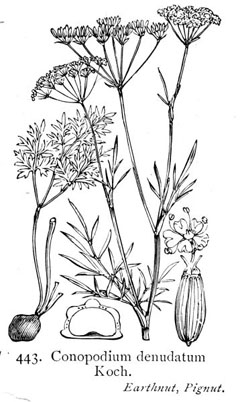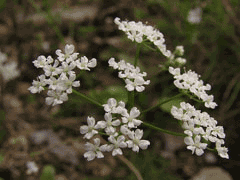 |
|
|
 |
| http://flickr.com/photos/tico_bassie/ |
Translate this page:
Summary
Physical Characteristics

 Conopodium majus is a PERENNIAL growing to 0.3 m (1ft).
Conopodium majus is a PERENNIAL growing to 0.3 m (1ft).
See above for USDA hardiness. It is hardy to UK zone 7 and is not frost tender. It is in flower from May to June, and the seeds ripen from July to August. The species is hermaphrodite (has both male and female organs) and is pollinated by Insects. The plant is self-fertile.
Suitable for: light (sandy), medium (loamy) and heavy (clay) soils. Suitable pH: mildly acid and neutral soils. It can grow in semi-shade (light woodland) or no shade. It prefers moist soil.
UK Hardiness Map
US Hardiness Map
Synonyms
C. denudatum. Bunium flexuosum.
Plant Habitats
Woodland Garden Sunny Edge; Dappled Shade; Shady Edge; Hedgerow; Cultivated Beds;
Edible Uses
Edible Parts: Root
Edible Uses:
Tubers - raw or cooked[2, 5, 12, 17, 63, 100]. A very pleasant food with a flavour somewhat between a sweet potato and hazelnuts, with a hot aftertaste of radish[115, 183, K]. We have never detected this hot aftertaste, and feel that the flavour is reminiscent of brazil nuts[K]. There is only one tuber on each plant, this is rather small and difficult to harvest, but the size could probably be increased by cultivation[115, K].
References More on Edible Uses
Medicinal Uses
Plants For A Future can not take any responsibility for any adverse effects from the use of plants. Always seek advice from a professional before using a plant medicinally.
None known
References More on Medicinal Uses
The Bookshop: Edible Plant Books
Our Latest books on Perennial Plants For Food Forests and Permaculture Gardens in paperback or digital formats.

Edible Tropical Plants
Food Forest Plants for Hotter Conditions: 250+ Plants For Tropical Food Forests & Permaculture Gardens.
More

Edible Temperate Plants
Plants for Your Food Forest: 500 Plants for Temperate Food Forests & Permaculture Gardens.
More

More Books
PFAF have eight books available in paperback and digital formats. Browse the shop for more information.
Shop Now
Other Uses
References More on Other Uses
Cultivation details
Never found on alkaline soils in the wild[12]. See the plants native habitat for other ideas on its cultivation needs. This species responds to cultivation by producing larger tubers[115]. With careful selective breeding it is probably possible to produce a much more productive plant[K]. For polyculture design as well as the above-ground architecture (form - tree, shrub etc. and size shown above) information on the habit and root pattern is also useful and given here if available. The plant growth habit is a clumper with limited spread [1-2].
References Carbon Farming Information and Carbon Sequestration Information
Temperature Converter
Type a value in the Celsius field to convert the value to Fahrenheit:
Fahrenheit:
The PFAF Bookshop
Plants For A Future have a number of books available in paperback and digital form. Book titles include Edible Plants, Edible Perennials, Edible Trees,Edible Shrubs, Woodland Gardening, and Temperate Food Forest Plants. Our new book is Food Forest Plants For Hotter Conditions (Tropical and Sub-Tropical).
Shop Now
Plant Propagation
Seed - sow spring in a cold frame. Germination is usually quick and good[K]. Prick out the seedlings into individual pots as soon as they are large enough to handle and plant them out when in early summer. It is also possible to sow in situ, though this requires a lot more seed to produce the same amount of plants from a protected sowing. Division in late summer as the plant dies down.
Other Names
If available other names are mentioned here
Native Range
EUROPE: United Kingdom (U.K.), Ireland, Norway, Belgium, Italy (incl. Sicily), Spain, France (incl. Corsica), Portugal,
Weed Potential
Right plant wrong place. We are currently updating this section.
Please note that a plant may be invasive in one area but may not in your area so it's worth checking.
Conservation Status
IUCN Red List of Threatened Plants Status :

Growth: S = slow M = medium F = fast. Soil: L = light (sandy) M = medium H = heavy (clay). pH: A = acid N = neutral B = basic (alkaline). Shade: F = full shade S = semi-shade N = no shade. Moisture: D = dry M = Moist We = wet Wa = water.
Now available:
Food Forest Plants for Mediterranean Conditions
350+ Perennial Plants For Mediterranean and Drier Food Forests and Permaculture Gardens.
[Paperback and eBook]
This is the third in Plants For A Future's series of plant guides for food forests tailored to
specific climate zones. Following volumes on temperate and tropical ecosystems, this book focuses
on species suited to Mediterranean conditions—regions with hot, dry summers and cool, wet winters,
often facing the added challenge of climate change.
Read More
Expert comment
Author
(Golian.)Loret.
Botanical References
17
Links / References
For a list of references used on this page please go here
Readers comment